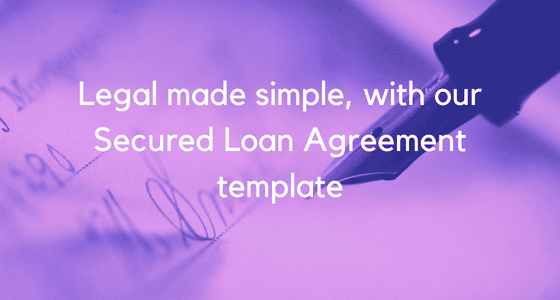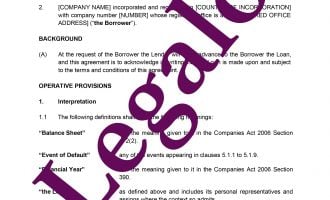Secured Loan Agreement
Our Secured Loan Agreement template:
- expertly-drafted template for peace of mind
- includes provision for security to be taken
- easy to edit and complete
- full guidance notes included

How Does It Work?
-
1. Download
-
2. Edit
-
3. Print
-
4. Sign
This is our Secured Loan Agreement template. This agreement requires that the borrower provides security against the loan. It might also be guaranteed by someone else.
We have drafted the secured loan agreement in a flexible manner. You can edit it to provide for interest to be charged or for the loan to be interest-free. Also you can select the situation where repayment will take place periodically or where repayment is to be made in one lump sum.
When to use our Secured Loan Agreement Template
It works for secured loans to or from individuals and companies. This loan agreement with security incorporates various options, so it is appropriate whether:
- interest is being charged or not;
- the loan is repayable in full in one lump sum or over a period by instalments;
- whether or not there is a separate guarantor of the loan; and
- the lender and borrower are companies or individuals.
This template presumes that there is security being provided to the lender for the loan by the borrower. If this is not the case, then you may need one of Legalo’s other loan agreement templates that would better suit you. Feel free to phone us on 0333 355 4900 if you are in doubt or need a steer on this.
Our other loan agreements are:
- standard loan agreement (no security – for unsecured loans);
- family loan agreement (no security – for a private loan to close family, unsecured);
- employee loan agreement (no security – for an unsecured loan); and
- loan agreement with guarantor (someone other than the borrower guarantees the loan will be repaid, but there is no legal charge involved).
Separately, you will need to buy either (a) our Legal Charge template if you are taking security over an individual’s freehold or long leasehold property or a company’s commercial property freehold or (b) our Debenture Agreement template if you are taking security over a company’s assets in general.
For more explanation on how our two templates work together to provide you with security for your loan, have a look at this blog article. Here is what Wikipedia says about security for loans.
If you have any difficulties in filling in the template, we offer free support by way of email and telephone, although this does not include giving legal advice.
Discount Packages from Legalo
If you want to buy both of the two templates you will need together, we offer them as packs at a 20% discount:
What about a guarantor?
You might not need a guarantor if you have good security by way of the legal charge. Sometimes it is the guarantor who is providing the legal charge. We have offered options in the template to cover the following scenarios where there is both a guarantor and a legal charge. So it can be used if you have the situation of:
(a) a secured loan where the legal charge is secured on the borrower’s property, and a guarantor, who is not also granting a legal charge; or
(b) a secured loan where a guarantor is the one granting a legal charge (and the borrower is not doing so), secured on the guarantor’s property.

FAQs on secured loan agreements
Below, we have answered the most popular questions on the Internet about secured loan agreements.
Can I write my own secured loan agreement?
Yes, you can. With Legalo’s template it is very quick and easy to do. Our templates all come with detailed guides. The guide walks you through what you need to do and explains each clause as you go along.
Does a security agreement have to be in writing?
In nearly every case, yes. You could only use a verbal security if the party taking the security was given physical possession of the assets being pledged as security. This might include valuable jewellery or goods: the owner could hand it over as security.
Verbal agreements are notoriously difficult to enforce. In other cases, a verbal “security” is likely to be impossible to enforce, as you will have no evidence it actually exists. That defeats the entire purpose of the security. With land being given as security, you would need it in writing by law. Otherwise, it falls foul of the Statute of Frauds 1677. This very old Act requires all guarantees or security over land to be in writing, in order to be valid and enforceable in the courts.
Why take the risk of getting it wrong and ending up with no security? With the great templates available from Legalo, it is easy and cheap to get the correct security that you need. Our templates take away the unnecessary risk.
Is a hand written loan agreement legal?
So long as you have the loan agreement in writing, then this is much better than having nothing in writing. However, to make sure you include all the necessary elements in your loan agreement, it is far better to use a template from Legalo. It also makes your life easier, as they are so quick to use and come with a full written guide.
What is a secured loan agreement?
A secured loan agreement is an agreement that refers to there being some security for the repayment of the loan. It specifies what that security is to be but usually that comes in the form of a separate document, such as a legal charge or a debenture (from a company). Legalo’s templates come in this separate form, so, when you buy the secured loan agreement, you also need either a legal charge or debenture. We’ve made it easy with our secured loan agreement discount packs, with 20% off:
How does a secured loan agreement work?
The loan agreement records the terms of the loan such as the amount lent, the dates of repayment and the rate of interest that applies. The security comes in the form of a separate specialised security document. The 2 templates then work together: the one recording the loan terms and the other backing it up with security.
What security do I take for a secured loan agreement?
The ideal security is a first legal charge registered over a UK property at the Land Registry, where you have done your “due diligence” and checked the property out, such as its market value as a minimum. If lending to a company you can take a debenture, which is a series of charges over all of the company’s assets. Hopefully, within those assets is a valuable freehold property on which you would register a separate legal charge.
Anything less than this level of security is less than ideal, such as a second legal charge, which ranks behind the party owning the first legal charge. Will there be enough equity security for you? What if the first lender lends more and erodes your equity? There is more about this in the next section below.
What is the best type of security?
(A) First Legal Charge
The best type of security is having a first legal charge over UK freehold or long leasehold property. You should still do your due diligence on the property and also have an independent and up-to-date valuation of it, to ensure it has sufficient equity in it.
(B) Second Legal Charge
A second legal charge is not as good as a first legal charge for 2 reasons:
- already someone ranks ahead of you and there is therefore less equity security left for you in the property; and
- the lender who holds the first legal charge might lend more money, knowing they rank ahead of you in priority for getting repaid, and thus erode your security. It could be eroded to nothing.
To get around this problem, banks taking a second legal charge ask for a “Deed of Priority” with the holder of the first legal charge, so that their security is not eroded.
One other point to note is that you usually need the consent of the first legal charge holder in order even to register your second legal charge. Get this in writing before you lend.
(C) Equitable Charge
An equitable charge is not very good: someone else could lend and take a legal charge and they would rank ahead of you in priority for repayment. Effectively, they could leapfrog you in this way at any time.
(D) Personal Guarantee (in writing)
While you might be able to establish how credit-worthy the guarantor is now, there is nothing to stop them giving other guarantees and/or becoming bankrupt. We have come across cases of company directors giving out numerous personal guarantees and those guarantees were to a total value of far more than their net assets. As a result, the directors were eventually made bankrupt when things went badly for the borrower-company and the guarantees were worthless.
When considering taking a personal guarantee, it is worth asking the guarantor to provide evidence of:
- valuations of their net assets, listing key assets such as properties, pension funds and other investments;
- the percentage they own in the equity in any properties;
- their current key debts, such as mortgages; and
- their exposure to other personal guarantees.
NB This does not prevent their offering many other personal guarantees in the future or selling / spending their assets.
(E) Other Security?
Other so-called security situations might include strange company structures where the directors claim that a central group company holds security by way of equitable charges and/or restrictions at the Land Registry in its favour. However, these are often hard to understand and you have no control over what the group does with them. For example, the directors might remove them and you would not know. This situation leaves lenders wide open to abuse and scams. You are best off avoiding lending to group companies in this manner.
Is a secured loan agreement legally binding in the UK?
To make your secured loan agreement binding in the UK, it needs to be clear and in writing, with a legal charge or other security (such as a debenture from a company). You need to register that security: at the Land Registry if over land; and also at Companies House if the borrower is a company. There’s a very strict 21-day deadline for the latter.
When should I use a secured loan agreement?
Whenever you make a loan of any significant size, then you should get adequate security. Sometimes that might be by way of a guarantee from someone else, but a better security is a legal charge (mortgage) that you register at the Land Registry over a freehold property.
What is the difference between a loan agreement and a security agreement?
These 2 documents do 2 different things. The loan agreement records the fact that you made a loan and the terms of its repayment. The security agreement provides the collateral for that loan: it states what property the borrower pledges as security for the repayment of the loan. You need the 2 documents together in order to make up the secured loan agreement with its security.
What documents do I need for a secured loan?
You can combine them into 1 document, but effectively you need 2 elements:
- the details of the loan – at Legalo, we cover this in our secured loan agreement; and
- the nature of the security the borrower is giving – at Legalo, we cover this in our legal charge.
We have kept our templates separate. this allows you to focus just on what each document covers when drafting them. Also it gives you the freedom when lending to a company to swap the legal charge security for a debenture if you prefer it. There’s no difficult re-writing: you simply couple the secured loan agreement with a debenture in that case.
What must be included in a security agreement?
The absolute basics to include are:
- names of the parties,
- the nature of the security that the borrower is giving, and
- a reference to what it secures, e.g. a loan.
Legalo’s great templates cover all of this and everything else that you need to get the best security and make enforcing it easier.

Guide to our Template
For a preview of the guide to the secured loan agreement, please see our very similar guide to our general loan agreement. Note the following main change to it below. (The full guide accompanies the template when you purchase it.) We have added an additional clause to allow a person other than the borrower to provide security for the loan.
8. Security (for the secured loan agreement)
Clause 8.1
This refers to the security the borrower is to grant. Select whether it is to be a legal charge over a freehold property (i.e. a mortgage) that the borrower owns or a comprehensive debenture over all of the borrower’s assets (a debenture commonly creates a series of fixed charges over most of the borrower’s assets and a “floating” charge over cash and stock, permitting the on-going use of cash and the sale of stock). Only a company can grant a debenture, so if the borrower is an individual, then delete the option that refers to a debenture. Legalo has templates available separately for you to use for the legal charge or debenture. As noted above, you should put such security in place at the same time that you make the loan. Don’t do it afterwards, as it might affect its validity.
If there is a guarantor and it is the only one granting the legal charge as security, there is no need to alter anything in this clause 8.1 to cater for that. This is because it will already refer to “the Property”, and you will have defined that earlier as being the property of the guarantor.
Clause 8.2 (optional)
If someone else is guaranteeing the loan, then add an extra clause as 8.2 with the following wording:
“8.2 The Guarantor guarantees to the Lender that the Borrower shall observe and carry out all of the Borrower’s obligations in this agreement. In the event that the Borrower fails to repay the Loan or to observe or carry out any of the Borrower’s obligations, the Guarantor shall promptly pay to the Lender any outstanding Loan repayments (and any interest due) and observe and perform the obligations on behalf of the Borrower. The Guarantor shall indemnify the Lender against any loss caused to the Lender as a result of the Borrower’s breach of its covenants or any part of this agreement.”
Using this Template
Once downloaded, you can use the agreement as many times as you require. It is downloadable in Microsoft Word format and includes full guidance notes. The guide explains the template clause-by-clause, to make it simple to complete. It tells you where you need to fill details in or choose different options. The average drafting time is fifteen minutes.
David, our co- founding solicitor of over twenty years, drafted this template. Therefore, you get a document template that you can rely on. For extra assurance, we also offer a full money-back guarantee of satisfaction on all of our document templates. (See our FAQs for more details of this.)
Just don’t forget to buy the legal charge or debenture template you require if you don’t already have a template for the one you need.



